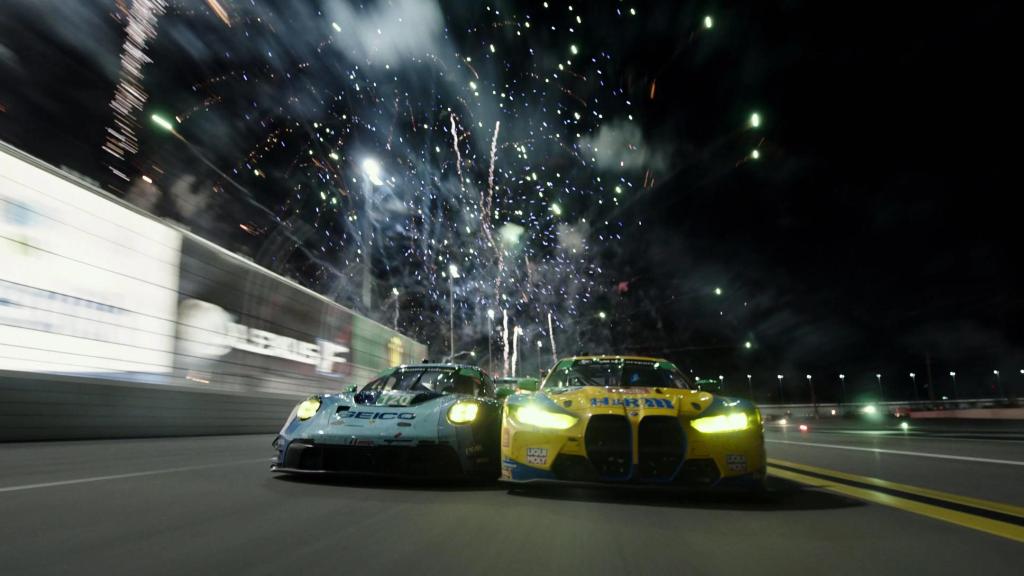
The currently popular "F1: Fast and Furious" tells a thrilling racing legend. Whether it is the metallic texture of the racing car, the driver's costumes, or the depiction of the atmosphere of various racing scenes and the immersive audio-visual experience, they all need a better screening environment to be presented to the extreme.

Stills from F1: The Fast and the Furious
The reporter of The Paper watched "F1: Fast & Furious" in the first Dolby Vision + Atmos theater in China. The vibration of the tires rolling over the curb came from under the seat, mixed with the metal collision sound of the gearbox shifting, and the constant switching to the low angle view inside the cockpit made the audience feel like they were running on the racetrack. This is indeed as a Douban movie review said: "If you don't go to the cinema, you don't need to watch this movie, because the effect will be greatly reduced."
The release of "F1: Wild Rift" has once again drawn everyone's attention to the topic of cinema configuration. Recently, Dolby Laboratories and Emperor Cinemas jointly announced that China's first theater using the "Dolby Vision + Atmos" solution has officially settled in Emperor Cinemas Beijing Sanlitun Taikoo Li flagship store. Opening Tao Piao Piao, you can find that in addition to the IMAX theater known for its large screen, the audience has new audio-visual options.
What is the difference between a theater equipped with "Dolby Vision + Dolby Atmos" and the more well-known "Dolby Cinema"? What kind of fresh experience can this model bring to the audience?

Halls 5 and 6 of Emperor Cinemas’ flagship store in Taikoo Li Sanlitun, Beijing are equipped with Dolby Vision + Atmos
Lan Xin, Director of Cinema Sales for Greater China at Dolby Laboratories, first introduced the development history of Dolby Vision and Dolby Atmos in an interview. Dolby began the research and development of imaging technology more than a decade ago. "At that time, our goal was to understand which image enhancement technologies had the greatest impact on the visual experience and truly immerse the audience in the story of the movie. We found that improving the contrast and brightness of the picture can greatly improve the visual experience. Dolby Atmos had already been loved by everyone, so Dolby Cinema came into being."
It is reported that the contrast ratio of Dolby Vision can reach 1 million:1, which is hundreds of times that of ordinary cinemas. It can show deeper dark areas while showing high brightness. The collision of warm and cold tones also reflects the different levels of changes in the same color system, making the visual experience more impactful. Dolby Atmos breaks the concept of traditional sound channels and introduces "sound objects", which allows creators to accurately place and move sound objects in three-dimensional space.
Li Chenghan, general manager of Emperor Cinemas (Mainland China), believes that when top-quality domestic and foreign blockbusters hold their premieres in China, they will definitely put forward requirements for the audio-visual experience of the cinema. "Every time the lights are turned on at a premiere, it is a tribute to the art of film. The choice of the audience is the answer. When it comes to technological innovation, we spare no expense."
On the creative side, Dolby Vision and Dolby Atmos also provide more possibilities for content creators. Lan Xin introduced, "Dolby Vision can make full use of everything captured by current camera technology to present the scenes seen by the director on the set to the audience through the big screen. During post-production, Dolby Vision can also give the creative team free space to make full use of the full color gamut, peak light, brightness and contrast, so that they have the confidence to make these images realistically reproduced in theaters equipped with Dolby Vision. Currently, more than 720 films around the world have been or are confirmed to be released with Dolby Vision and Dolby Atmos."
"In terms of sound, when using a traditional channel-based sound system, filmmakers need to fully consider the number and position of speakers. Dolby Atmos only requires content creators to simply place or move a certain sound to a certain position in the theater space to create a feeling for the audience as if they are in the world of the movie. For example, the chirping of birds, soaring in the sky, and perching on branches. The sound performance you feel in the theater can be exactly the same as the real scene when you are hiking in the forest." Lan Xin said.

Effect display
Content produced with Dolby Vision and Dolby Atmos can be played in Dolby Cinemas and the new Dolby Vision + Atmos theaters.
Among them, Dolby Cinema is a film projection system launched by Dolby in 2014. It has a series of unique design elements, such as the iconic entrance and dynamic audio-visual corridor, the wall-to-wall-to-ceiling screen, downward-shielding guide lights and sound-transparent materials, and other design elements that can enhance the audio-visual effects.

Cinema interior
However, the design of the latest "Dolby Vision + Atmos Cinema" projection system is different from that of Dolby Cinema. Its design is defined by the cinema.
Li Chenghan introduced that Emperor Cinemas has its own unique design language. For example, all seats are customized, with high slope and no obstruction, low viewpoint and wide row spacing. "The Taikoo Li Sanlitun flagship store has won the box office champion in Beijing many times. This time, we upgraded Hall 5 and Hall 6 to China's first Dolby Vision + Atmos theater, marking the ultimate evolution of the flagship store's audio-visual experience."
